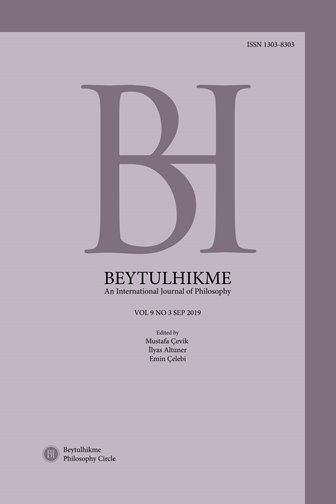Author :
Abstract
Bu çalışma Platon’un Timaios diyalogunda ortaya koyduğu evren anlayışının hangi ilkeler temelinde oluşturulduğunu ve bu ilkelerin bireysel insanın etik yaşamı açısından açımladığı anlamı sorgulanmayı amaçlamaktadır. Bu açıdan makalenin ilk bölümünde Platon’un evren tasarımının, evrene ilişkin olası bir açıklama olduğu tartışılmakta ve ikinci bölümde bu tasarımın teleolojik yönelimi ortaya çıkarılmaktadır. Bu teleolojik yaklaşım, makalenin temel iddiası olan Platon’un kozmolojisinin etik bir bağlama sahip olduğu ve insan yaşamının nihai hedefi olan iyiye yönelik arayışını açımladığı düşüncesini belirginleştirmektedir. Makalenin üçüncü ve dördüncü bölümleri, Platoncu evren tasarımının dayanağı olan akli ve zorunlu neden ilkesini belirginleştirirken, beşinci bölüm bu iki nedenin işbirliğiyle yaratılan bütünsel evrenin yapısına odaklanmaktadır. Bu şekilde iki nedenin işbirliğiyle yaratılan, düzen ve harmoniyi sergileyen evren, insan yaşamına rehberlik edecek modeli sağlamaktadır. Çalışma, makrokozmoz ve mikrokozmoz arasındaki benzerlik nedeniyle, insan ruhunun üçlü yapısı aracılığıyla kozmik düzeni model alarak etik ve politik yaşamda iyi ideasının nasıl edimselleştirilebileceğini ve mutluluğa nasıl ulaşılacağını üzerinde durarak sonuç bölümüyle tamamlanmaktadır.
Keywords
Abstract
This study aims to inquire about the principles on which Plato’s understanding of the universe he revealed in Timaeus dialogue is based, along with the meaning of these principles in terms of the ethical life of the individual human. Upon the analyses of this inquiry, Plato’s universe design is discussed as a possible explanation for the universe in the first part of the article, and the teleological orientation of this design is expounded in the second part. The teleological approach emphasizes that Plato’s cosmology has an ethical context, which is the basic claim of the article and searches for the ultimate goal of human life for the good. While the third and fourth parts of the article highlight the principle of rational and necessary conditions, which are the basis of the Platonic universe design, the fifth part focuses on the structure of the holistic universe created by the collaboration of these two conditions. In this way, the universe was created through the collaboration of the two conditions and exhibits the order and the harmony which provide a model guide for human life. By focusing on how to actualize a good idea in ethical and political life and how to achieve happiness through taking the cosmic order as a model through the triple structure of the human soul the article concludes that there is a similarity between macrocosmos and microcosmos.
Keywords
- Conford, F. M. (1997). Plato’s Cosmology: The Timaeus of Plato. İndianapolis: Hac- kett Publishing Company.
- Erdoğan, E. (2008). Platon’da Bilgisizlikten Bilgiye Giden Süreç. Kaygı, 11, 211-221.
- Gadamer, H. G. (1980). Dialogue and Dialectic: Eight Hermeneutical studies on Plato. (Trans. P. C. Smith). New Haven and London: Yale University Press.
- Gregory, A. (2008). Plato: Timaeus and Critias (Trans. R. Waterfield). New York: Oxford University Press.
- Johansen, T. K. (2008). Plato’s Natural Philosoph : A Study of the Timaeus-Critias. New York: Cambridge University Press.
- Lisi, F. L. (2007). Individual Soul, World Soul and the Form of the Good in Pla- to’s Republic and Timaeus. Etudes Platoniciennes, 4, 105-118.
- Mason, A. S. (2006). Plato on Necessity and Chaos. Philosophical Studies, 127 (2), 283-298.
- Menn, S. (1995). Plato on God as Nous. Carbondale and Edwardsville: Southern Illinois University Press.
- Morrow, G. R. (1950). Necessity and Persuasion in Plato’s Timaeus, The Philosop- hical Review, 59 (2), 147-163.
- Mutlu, E. Ç. (2016). Platon İçin Hakikatin Olmadığı Yerde Olabilir Olanın Yeri: Eikos. Özne: Platon, 24, 11-20.
- Pettersson, O. (2013). Plato on Necessity and Disorder. Frontiers of Philosophy in China, 8 (4), 546-565.
- Steel, C. (2001). The Moral Purpose of the Human Body: A Reading of Timaeus. Phronesis, 46 (29), 105-128.
- Peters, E. F. (2004). Antik Yunan Felsefesi Terimleri Sözlüğü (Çev. Hakkı Hünler). İstanbul: Paradigma Yayıncılık.
- Platon (1971). Devlet. (Çev. S. Eyüboğlu, M. A. Cimcoz). İstanbul: Remzi Kitabevi.
- Platon (2001a). Timaios. (Çev. E. Güney, L. Ay).İstanbul: Sosyal Yayınlar.
- Platon (2001b). Phaidon. (Çev. H. R. Atademir, S. K.Yetkin). İstanbul: Sosyal Yayınlar.
- Platon (2012). Yasalar. (Çev. C. Şentuna, S. Babür). İstanbul: Kabalcı Yayınevi.
- Platon (2013). Philebos. (Çev. F. Akderin). İstanbul: Say Yayınları.





